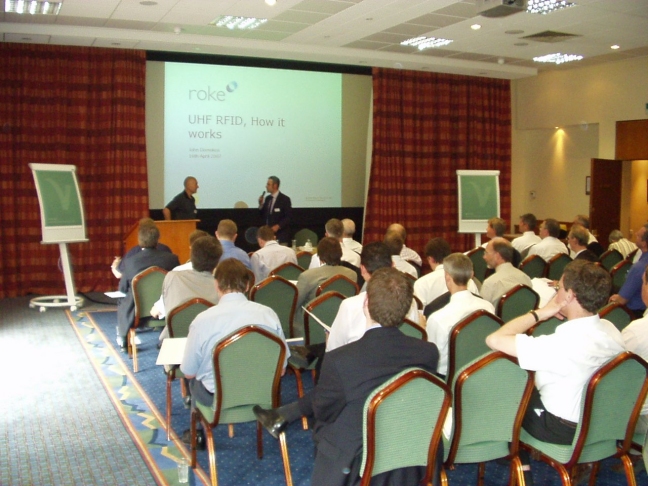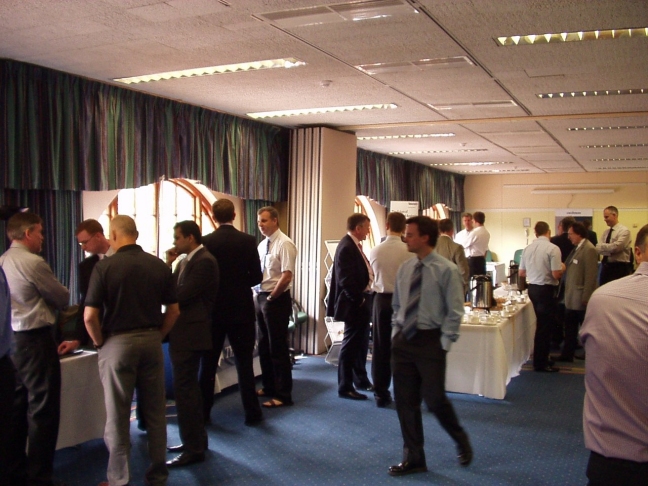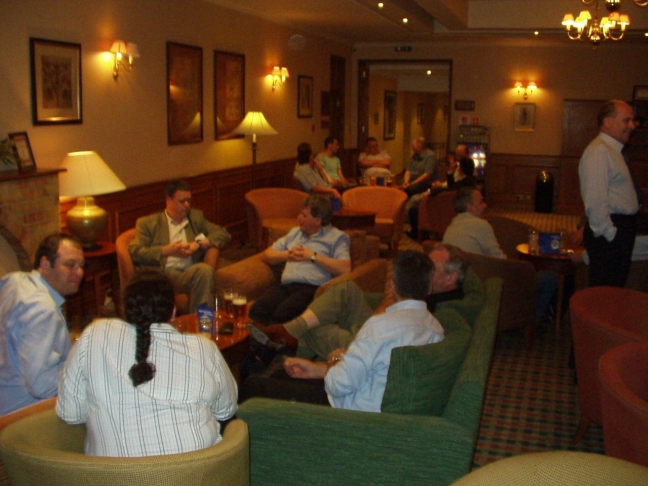 |  |  |
Milton Hill House
Steventon
Oxfordshire
OX13 6AF
| Tel | 0870 609 1153 |
| Web | http://www.devere.co.uk/venues/Milton-Hill-House/ |
Matthew Harper
NPL
| Tel | 020 8943 6849 |
| Matthew.Harper@npl.co.uk |
30 Years of RF and Microwave CAD Tools - Where are we Now? | |
| Malcom Edwards | |
| AWR | |
| Remember SuperCOMPACT and Touchstone Dos? From the days of netlists and early Spice variants of the 1980s, RF and Microwave CAD has constantly been evolving, adding layout, GUI and HB simulation. However in the last 20 years what has changed? Certainly system level tools and EM analysis have shown technological advances but the biggest single change has to be the integration of various point solutions into one integrated design flow. The theme of this presentation is to demonstrate the advantages of an integrated design suite and how it makes designers’ lives easier by embracing not only the technology but the philosophy behind the technology. | |
60GHz Transceiver Building Blocks and Measurement | |
| Frank van Vliet | |
| TNO Defence, Security and Safety | |
| The increasing demand of frequency bandwidth for broadband wireless applications results in surveys to new frequency bands, suitable for high data-rate applications. The 60 GHz band is one of the candidates for this type of applications. Due to the high operating frequency the 60 GHz topic is challenging for IC design and measurement. Integration of building blocks is important to minimise high frequency interconnects, which are uncertain design factors. Building blocks for a 60 GHz transceiver MMIC and antenna, designed and measured at TNO, are presented in this paper. | |
| 60GHz Transceiver Building Blocks and Measurement | |
Comparison of TLM, FIT-TD and FIT-FD for the Modelling of a PIFA Antenna | |
| Paul Duxbury | |
| CST | |
| There are many different methodologies which can be used for solving Maxwell\'s Equations for electromagnetic problems. While all solving the same basic problem, they have some fundamental differences. The major differences relate to the domain in which they solve (time or frequency) and also the type of mesh which they use (hexahedral or tetrahedral). This paper will look at three of those techniques; Time Domain Transmission Line Matrix using a hexahedral mesh, Time Domain Finite Integration using a hexahedral mesh and Frequency Domain Finite Integration using both a hexahedral and tetrahedral mesh. These different techniques will be compared using a stylised mobile phone PIFA antenna. | |
Design and Measurement of a Wideband InP SDLA | |
| Merv Haynes | |
| Selex SAS | |
| The design and measurement of a Wideband Successive Detection Logarithmic Amplifier (SDLA) Monolithic Microwave Integrated Circuit (MMIC) using InP double heterojunction bipolar transistor technology (DHBT), is described in this paper. The MMIC uses cascaded differential amplifier gain stages together with full wave detectors to achieve a piecewise linear approximation to the ideal logarithmic response. The configuration also includes a limited RF output and on chip adjustment for gain and detector slope. The integrated circuit provides 33dB dynamic range across 2-18GHz for a ?1dB log error, with a limited RF output of > -2.2dBm. The circuit consumes 690mW from a single -5V supply rail in a chip area of 2.58mm2. | |
| Design and Measurement of a Wideband InP SDLA | |
Dual IQ for Complex RF Demodulation | |
| Lindsay McInnes | |
| NPL | |
| In-phase and Quadrature (IQ) timing referencing of digital sampling oscilloscopes (DSOs) can correct for jitter and timebase nonlinearity and can also be used to demodulate both simple and complex RF waveforms. At high frequencies/jitter, however, IQ alone can be insufficient. We outline preliminary tests of a dual IQ scheme in which an additional slower IQ reference is introduced to resolve these issues. We also discuss its application to sampler nonlinearity and progress towards traceable waveform metrology. | |
| Dual IQ for Complex RF Demodulation | |
Measurement of Oscillator Phase and Amplitude Noise at W-band | |
| Andy Stove | |
| Thales | |
| This paper will describe a technique for the measurement of oscillator noise at frequencies around 75-95GHz Oscillator noise sidebands are particularly significant for modulated continuous wave radars, where the sidebands of the transmit/receive leakage can degrade the system noise figure. Measuring oscillator noise is also a particular challenge at higher millimetre-wave frequencies where components are relatively narrow-band and measuring systems relatively insensitive. Phase noise at a few hundred kilohertz from carrier can be measured using spectrum analysers, but further from carrier they are not sufficiently sensitive, and close to carrier noise can be hard to measure due to the high drift rate of the carrier. The phase noise, however, can to be cancelled by careful adjustment of the local oscillator path lengths, so that the, inherently much lower, AM noise levels can in fact limit system sensitivity, and the sensitivity of the test rig to AM and FM noise can be measured with calibration signals. Phase noise is most sensitively measured by beating together two oscillators, and measuring the spectrum of the resulting beat signal. This is a more sensitive scheme than using the harmonic mixtures conventionally used with spectrum analysers. By performing multiple measurements with multiple oscillators, the noise levels of the individual oscillators can be deduced. | |
| Measurement of Oscillator Phase and Amplitude Noise at W-band | |
Measuring Output VSWR For An Active Levelled Source | |
| Paul Roberts | |
| Fluke UK | |
| Mismatch error is one of the major contributions to measurement uncertainty in RF & Microwave calibration. When a signal source is used in calibration applications, knowledge of the output impedance (or source VSWR) is necessary to enable users to estimate the mismatch uncertainty contribution when performing their measurement uncertainty calculations. However, measuring the output match of an active levelled source can be difficult. The measurement techniques generally used for passive components cannot be used for active levelled sources. If those methods are used, they are likely to give erroneous misleading results. This paper discusses the output VSWR measurement method chosen for use in manufacturing test and calibrations systems for a new RF & Microwave source instrument. It also describes the steps taken to validate results by comparisons with other methods less well-suited for automation and production line usage. | |
| Measuring Output VSWR For An Active Levelled Source | |
Oscilloscopes Evolve to Meet New Measurement Challenges | |
| Richard Martin | |
| Yokogawa | |
| As logic speeds increase and signal-integrity issues increasingly relate to analogue effects on logic signals, there is an increased need for a single measurement tool that can look at both signal environments with no loss in performance in either mode. This paper shows how the most ubiquitous of electronic measuring instruments - the oscilloscope - is evolving to address the challenges of the modern embedded world. | |
| Oscilloscopes Evolve to Meet New Measurement Challenges | |
Panel Session: “Short Range Wireless Technologies - Do We Need Multiple Standards” | |
| Chairman: Simon Day (Phasor Design) | |
| Panel members: Robin Heydon (CSR), Tony Lucido (Jennic), Gordon Lindsay (Broadcom), Brian Back, (Radio-Tech) | |
| \"Over the last decade, the use of short range wireless links has become increasingly popular to link together devices such as mobile phones, cars, PCs and their peripherals. As a result of this, several short range communication standards have evolved such as Bluetooth, Zigbee, Wibree and now the up and coming UWB which is also now seen as an extension to Bluetooth. With the ISM band becoming evermore congested should we look to harmonise to one standard and perhaps further look to a permanent band allocation for such devices? A panel of industry experts will lead a debate on the pros and cons of multiple standards and whether there really is a need for them all or ultimately should we look to define a single solution.\" | |
Solution Looking for a Problem: the Fe3+:Sapphire Whispering-gallery-mode 12.04 GHz Maser Oscillator as an X-band Microwave Source of Extremely Low Phase Noise. | |
| Mark Oxborrow | |
| NPL | |
| According to Leeson’s model, a loop oscillator comprising a high-Q resonator and a low-noise sustaining amplifier will exhibit low phase noise. The cryogenic Fe3+:sapphire Whispering-Gallery-mode 12.04 GHz Maser Oscillator, or \"WhiGMO\" for short, provides these two ingredients in the extreme: a resonator with a Q of around one billion in conjunction with extremely quiet solid-state maser amplification. In contrast to (tunable) ruby masers, no external dc magnetic field need be applied; the WhiGMO is a \"zero-field\" device. Its speculated and measured performance, as well as its operational requirements and limitations, shall be discussed. The WhiGMO’s potential in a few obvious applications (as a frequency/phase reference) shall be considered. Some less-obvious potential applications shall then be solicited from the audience...! | |
| Solution Looking for a Problem: the Fe3+:Sapphire Whispering-gallery-mode 12.04 GHz Maser Oscillator as an X-band Microwave Source of Extremely Low Phase Noise. | |
The RF Modelling of a Communications Satellite | |
| Peter James | |
| Astrium | |
| The increasing complexity of today’s telecommunications satellites, due to the incorporation of more and more components, coupled with their operators’ desire for increased capabilities is placing increased pressures on the RF modelling of such satellite payloads. Previously, conventional payloads have been modelled successfully in RF terms by using spreadsheet software tools that allowed predictions to be made with confidence. However some calculations such as spurious signals or inter-modulation levels and locations, phase noise, Bit Error Rate (BER) and interference are more difficult entities to model. It would be an advantage if these quantities could be modelled with some degree of confidence and in this way complement the existing modelling tools and methods. An approach taken on a theoretical development study here at Astrium Portsmouth has been to create accurate RF models of each piece of equipment at an early stage in the modelling process and to assemble these together into a single chain of a generic payload model. The aim being to upgrade these components as a project evolves. The software tool chosen to model these equipments has been Agilent’s Advanced Design System or ADS, which has been shown to be an accurate and flexible software system. When a set of individual equipment models has been created, it is a relatively simple process to connect these together into an overall systems model that links the receive antenna through the RF amplification and conditioning chain to the final transmit antenna. This paper will present some of these generic models, some theoretical results and show the various tools that could be applied to test the functionality of a future payload. | |
| The RF Modelling of a Communications Satellite | |
Thermal Measurement a Requirement for Monolithic Microwave Integrated Circuit Design | |
| Richard Hopper | |
| De Montfort University | |
| The paper will present the state of the art infrared (IR) microscopy facility at De Montfort University which uses a Quantum Focus instrument with state of the art spatial resolution of around 2.6 microns in the 2 to 5 micrometer wavelength band. The instrument has also been set up to make on wafer and packaged device measurements. The paper will describe the IR measurement technology necessary to obtain accurate 2-D thermal profiles on the surface of electronic devices. The measurement procedure will be explained, including the device mounting arrangement and emissivity correction techniques. | |
| Thermal Measurement a Requirement for Monolithic Microwave Integrated Circuit Design | |
Ultra Low Capacitance Schottky Diodes for Mixer and Multiplier Applications to 400 GHz | |
| Byron Alderman | |
| RAL | |
| Low capacitance GaAs Schottky diode technology is essential for millimetre and sub-millimetre wave heterodyne receivers. Schottky diodes operate at both ambient and cryogenic temperatures and are uniquely able to cover the full frequency range from DC to above 1?THz. Schottky diode technology has been evolving for many years and has traditionally been driven by the demands of radio astronomy and remote sensing of the atmosphere. Ground based applications, e.g. security imaging, are now increasing in importance. and, fFor these, applications, Schottky -based systems technology can beoffers an attractive alternative to detectors and sources that require cryogenic cooling. Advanced Precision fabrication techniques are required to form these the diode structures., which These typically consist of two parallel 20? ?m long gold air-bridges passing over a channel, of depth 4? ?m, to make contact to an anodes of which have a sub-micron arearadius.. This approach is required to reduce the parasitic capacitance of the diode, which increasingly dominates the high-frequency response as the frequency rises. The on-wafer diode-to-diode variation in electrical parameters for fabricatedthese devices is low with and a mechanical yields in excess of 95? % are achieved. RF demonstration Incorporation of the Schottkyse devices in heterodyne detectors produces yields near state-of-the-art results at 183?GHz, the characteristic frequency of a molecular important water vapour absorption line that is important for remote sensing of 183 GHz. A process tTo further improve the reliability of this these structuresSchottky technology will be reported., a process has been developed to In this, we integrate the air-bridged diode structures with an impedance matching networks. , thusThis eliminatesing the traditional process step of flip-chip soldering a discrete flip-chip diodes onto a traditional gold-on-quartz filters. | |
| Ultra Low Capacitance Schottky Diodes for Mixer and Multiplier Applications to 400 GHz | |
Any companies interested in having a stand at the exhibition that accompanies the next conference should send an email to: exhibition@armms.org
Contributions are invited with an emphasis on RF and microwave design, research, testing and associated subjects. An oral presentation will be made at the meeting and a written paper will be required for publication in the society digest, which is distributed to delegates at the meeting. Prospective speakers are requested to submit a title and a short abstract to the technical coordinator (see above) as soon as possible.
Click here to view our Guidelines for Authors
Click here to view our Publication Release Form